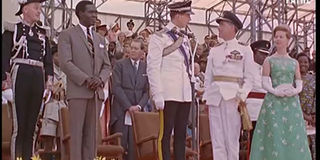Prime
Drawing the parallels between colonial and Museveni’s regimes

Left to right: Governor Sir Walter Coutts, prime minister Apollo Milton Obote, Duke of Kent Edward (centre), and Duchess of Kent Katharine (right) during celebrations to mark Uganda’s Independence at Kololo in Kampala on October 9, 1962. PHOTO/FILE/COURTESY
What you need to know:
- Book title-- Governing Uganda: British Colonial Rule and Its Legacy
- Author: Gardner Thompson
- Pages: 239
- Price: Shs18,000
- Where: Aristoc Booklex.
- 2003: The year the book was published.
As post-colonial Uganda continues to circle the drain with different arms of government in decline, many Ugandans have often wondered aloud if it would not be best for us to return to colonial rule. Although “Governing Uganda: British Colonial Rule and Its Legacy” by Gardner Thompson is avowedly not an apologia for colonial rule, it would serve the arguments of many of those who look back on the colonial period with longing and nostalgia.
According to his official biography, Thompson taught in Kampala from 1970 to 1972. Following an MA at the School of Oriental and African Studies, he undertook research on the colonial period in Uganda, at the Institute of Commonwealth Studies, and was awarded his PhD by London University in 1990. The 2003 publication of “Governing Uganda: British Colonial Rule and its Legacy” led to his election as a Fellow of the Royal Historical Society. Deservedly so, since his book is a paragon of historical accuracy and forensic brilliance as it investigates the British colonial state with a prime eye on the 1940s. Thompson, through painstaking research and academic inquiry, shows how the Second World War (1939-1945) stretched the fabric of colonial rule to breaking point, thereby leaving the colonial state naked.
He also, with elegant prose, demonstrates how the war transformed the British-Ugandan collaborative economic relationships, which lay at the beating heart of colonial rule, to an antagonistic dichotomy which could only lead to Uganda’s independence.
The author’s central argument is that there is a connecting thread between the colonial state as exposed by the Second World War and woven into the post-colonial state, including President Museveni’s rule.
He shows how the colonial state influenced Uganda and how Ugandans influenced the colonial state in ways that oppose historical discontinuity as argued by those who think pre and post-colonial Uganda are mutually exclusive.
The author further draws parallels between the similarities of the colonial regime of the 1950s and the Museveni government in a way that crystallises our understanding of the latter. In this vein, the author lays bare so many fictions about colonial rule—fictions that we regard as truisms in the historiography of Uganda. For instance, the colonial state has often been said to exercise “absolute power.” However, the author argues, such absolutism was impossible given the inadequacies of colonial rule. These inadequacies reveal that the British presence on the ground was too thin to be characterised as “absolute.”
“In 1955, the population of Lango District was 340,000. In his annual report, the district commissioner pointed out that for most of the year his administrative staff numbered just three men (including himself),” Thompson writes. This, he adds, demonstrates that insufficient manpower could not have sustained an absolutist regime.
Then, on the “myth” of exploitation of Uganda by the colonial state, Thompson shows how the colonial state had to “pay its way” by becoming economically viable. And so the British introduced cash crops such as cotton and coffee, which racked up the biggest export earnings for Uganda under colonialism. The cash-crop producing farmers would be taxed in order to provide revenue for the colonial state, but they would also have increased household incomes, thanks to increased production, to buy imported manufactured goods. Gardner says this symbiotic relationship benefited both the farmer and the colonial state.
As far as mineral exploitation goes, “Uganda’s exports in the Blue Book for 1944 are illuminating. Only two minerals make the table: [£]68,000 worth of tin ore was exported, and [£]20,000 of gold bullion. This was less than two percent of total exports in value; by contrast, cotton and coffee together accounted for 80 percent,” he writes. He also shows that workers in mines who received inadequate war-time wages simply left the mines, so where was the exploitation?
On the subject of the British Policy of Divide and Rule, Thompson again shows the other side of the coin as the colonial power is described as an arbiter of conflicting interest groups in Uganda. The colonial machine, in order to run efficiently, required harmony and so promoted accommodation between said conflicting interests.
As far as religious differences go, it is clear, the author argues, that these germinated before the establishment of colonial rule. Again, it is widely [and mistakenly] believed that tribes from the south of Uganda, especially Baganda, were kept out of the army by the British. Yet, as records show, there were almost 12,000 Baganda in military service in 1943, during the Second World War. This was three times the number of Acholi in the army at the time.
Even before that, in 1939, the British Colonial Authorities sought to recruit Ugandans for a Uganda territorial battalion. After advertisements were made, 800 applicants for 100 places were received, 60 out of the selected 100 were Baganda.
Even after independence, the number of Baganda in the officer corps was illustrative of a different story to the one we have been force-fed in order to nurture the British-preferred-northerners-in-the-army narrative.
Yes, there were 16 Baganda officers in the Ugandan army in 1966 compared with the 26 Acholi and 23 Langi officers.




